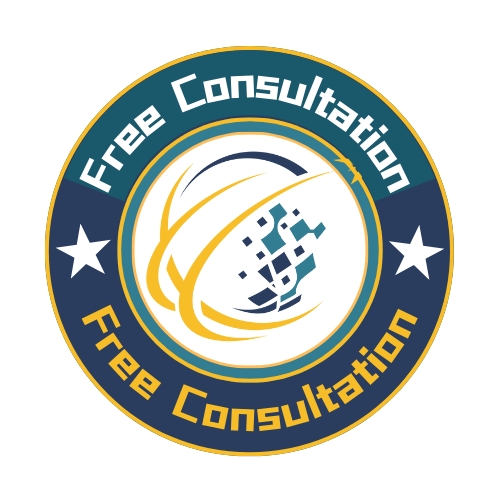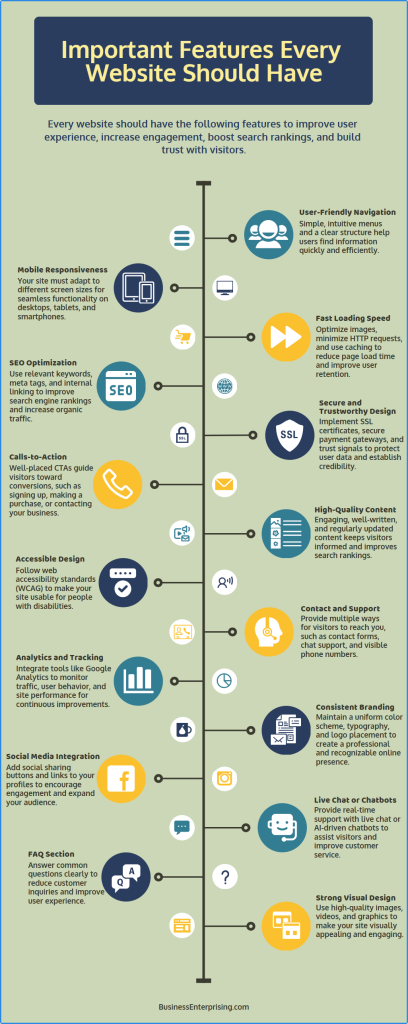
These features work together to make your website more accessible, engaging, and trustworthy. Consequently, visitors are more likely to interact with your content and complete desired actions. Therefore, investing time and resources into these aspects is essential for establishing a strong online presence.
User-Friendly Navigation
Intuitive menus and clear categories are important website features that significantly enhance user experience. When visitors can easily find what they’re looking for, they are more likely to stay longer and engage with your content. This ease of navigation reduces frustration and increases satisfaction.
Clear categories help users understand your site’s structure. By grouping related content logically, you guide visitors to their desired information swiftly. This logical arrangement minimizes the effort users need to find what they need.
Easy access to key pages is essential. Placing important links prominently ensures users can reach them without unnecessary clicks. This straightforward approach keeps users engaged and reduces the chance of them leaving your site prematurely.
Incorporating these navigation principles not only benefits users but also enhances your site’s performance. Search engines favor well-structured websites, potentially improving your search rankings. Therefore, focusing on user-friendly navigation is a strategic move for your online presence.
Mobile Responsiveness
Mobile responsiveness stands as one of the most important website features. With a significant portion of users accessing websites via smartphones and tablets, your site must adapt seamlessly to various screen sizes. This adaptability ensures that visitors have a consistent and user-friendly experience, regardless of the device they use.
A mobile-responsive design enhances user experience by adjusting content layout to fit different screens. This means images resize appropriately, text remains readable, and navigation stays intuitive. Consequently, users can interact with your site effortlessly, leading to increased engagement and satisfaction.
Moreover, search engines favor mobile-friendly websites in their rankings. Therefore, a responsive design can improve your site’s visibility in search results, driving more organic traffic. Additionally, faster loading times associated with responsive designs reduce bounce rates, keeping visitors on your site longer.
Implementing a responsive design also streamlines maintenance efforts. Instead of managing separate versions for desktop and mobile, you maintain a single site that adjusts to all devices. This approach saves time and resources, allowing you to focus on content and user engagement.
Embracing mobile responsiveness is essential for providing a positive user experience, improving search rankings, and simplifying site management. By ensuring your website adapts to various devices, you meet user expectations and stay competitive in the digital marketplace.
Fast Loading Speed
Fast loading speed is among the most important website features impacting user retention, SEO rankings, and overall performance. When your site loads quickly, visitors are more likely to stay and engage with your content. Conversely, slow load times can frustrate users, leading them to leave your site prematurely. Therefore, prioritizing speed is essential for maintaining user interest.
Search engines consider page speed when determining rankings. Faster websites often achieve higher positions in search results, increasing visibility and attracting more organic traffic. Additionally, efficient load times enhance crawl efficiency, allowing search engine bots to index more of your site’s content. Consequently, improving speed can boost your site’s SEO performance.
To optimize load times, consider compressing and optimizing images, as large image files can slow down your site. Additionally, limit the number of HTTP requests by reducing the number of elements on your pages. Utilizing browser caching can also help, as it allows returning visitors to load your pages more quickly. Furthermore, minimizing the use of external scripts can prevent delays in rendering your content. By implementing these strategies, you can enhance your website’s speed and provide a better experience for your users.
SEO Optimization
Optimizing your website for search engines involves several important website features that enhance visibility and user engagement. Meta tags, for instance, provide search engines with concise information about your page’s content. By crafting descriptive title tags and meta descriptions, you can improve click-through rates from search results. Additionally, incorporating relevant keywords naturally throughout your content helps search engines understand your page’s focus. However, avoid keyword stuffing, as it can harm your rankings.
Internal linking is another key aspect of SEO. By linking related pages within your site, you guide visitors to additional content and help search engines discover and index your pages. This strategy can distribute page authority and improve the ranking potential of important pages. Furthermore, creating high-quality content that addresses your audience’s needs encourages longer visits and reduces bounce rates. Therefore, focus on producing informative and engaging material that provides value to your readers.
Incorporating these SEO elements can significantly boost your site’s performance. By paying attention to meta tags, keywords, internal linking, and content quality, you enhance your website’s appeal to both users and search engines. Consequently, these efforts can lead to higher search rankings and increased organic traffic.
Secure and Trustworthy Design
Establishing a secure and trustworthy website design is essential for protecting user data and building credibility. Implementing SSL certificates encrypts the data exchanged between your site and its visitors, safeguarding sensitive information. This encryption prevents unauthorized access and assures users that their personal details remain confidential.
Additionally, integrating secure payment gateways is crucial for handling transactions safely. By using reputable payment processors, you protect customers’ financial information during purchases. This security measure not only prevents fraud but also fosters trust, encouraging users to complete transactions on your site.
Furthermore, displaying trust signals can enhance your site’s credibility. Elements such as security badges, customer reviews, and clear privacy policies reassure visitors of your site’s reliability. Therefore, incorporating these features can increase user confidence and engagement.
Incorporating SSL certificates, secure payment gateways, and trust signals are important website features that contribute to a secure and trustworthy design. By prioritizing these elements, you protect user data and build a credible online presence. Consequently, users are more likely to trust and engage with your website.
Clear Calls-to-Action (CTAs)
Strategic calls-to-action (CTAs) are important website features that guide visitors toward desired actions, thereby driving conversions and encouraging user engagement. By clearly indicating the next steps, you help users navigate your site effectively. This guidance reduces confusion and enhances the overall user experience.
Well-placed CTAs can significantly boost conversion rates. For instance, a prominent “Sign Up Now” button can prompt visitors to subscribe to your newsletter. Similarly, a “Buy Now” button can encourage immediate purchases. Therefore, by directing users toward specific actions, you increase the likelihood of achieving your business goals.
Additionally, CTAs play a crucial role in user engagement. By inviting users to explore more content or participate in offers, you keep them engaged with your site. This engagement not only enhances their experience but also increases the time they spend on your site. Consequently, this can lead to higher chances of conversion.
To maximize the effectiveness of your CTAs, consider their design and placement. Ensure they stand out visually and are located where users can easily find them. Additionally, use compelling language that clearly communicates the benefit of taking the desired action. By doing so, you can effectively guide visitors toward actions that align with your objectives.
Conclusion
Incorporating user-friendly navigation, mobile responsiveness, fast loading speeds, SEO optimization, secure design, and clear calls-to-action are important website features that enhance user experience and drive engagement. By focusing on these elements, you create a site that is accessible, efficient, and trustworthy. Consequently, visitors are more likely to interact with your content and complete desired actions. Therefore, prioritizing these features is essential for building a successful online presence.



